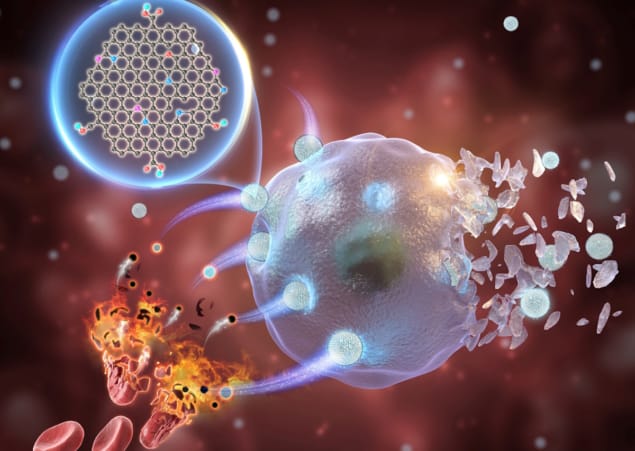
A team of researchers in China has pioneered the use of novel metal-free graphene quantum dots (GQDs) for chemodynamic therapy, an emerging non-invasive cancer treatment. The breakthrough paves the way for an efficient and cost-effective means of improving the catalytic activity of GQDs, while addressing the toxicity concerns linked with metal-based nanozyme treatments.
Reducing side effects
In recent years, metal-based nanozymes (nanomaterials with enzyme-like characteristics) have shown strong potential as therapeutic agents for chemodynamic therapy. The treatment works by using the nanozymes to catalyse the breakdown of hydrogen peroxide in cancer cells, leading to the production of highly cytotoxic hydroxyl radicals. Moves to use them more widely, however, have been hampered by the presence of persistent off-target side effects associated with metal toxicity.
In an effort to overcome these limitations, the team – led by Hui Wang from the Hefei Institutes of Physical Science (HFIPS) at the Chinese Academy of Sciences – used a relatively simple “one pot” process to synthesize n/p co-doped graphene quantum dots (NPGQDs) – metal-free nanozymes, derived from red blood cell membranes. The NPGQDs proved highly effective in treating tumours with fewer side effects.
Publishing their findings in the journal Matter, the researchers outline how they used NPGQDs as a Fenton-like reagent, which can catalyse hydrogen peroxide to generate hydroxyl radicals in a slightly acidic tumour environment, leading to intracellular oxidative damage and the inhibition of tumour cell proliferation.
In vitro studies of cancer cells showed that the NPGQDs induced apoptosis and ferroptosis (two types of cell death). The researchers also treated tumour-bearing mice with NPGQDs, observing 77.71% inhibition of tumour growth following intravenous injection and 93.22% inhibition for intratumoural injection, with no off-target toxicity.
“Notably, the synergistic electron effect of introducing nitrogen and phosphorus into GQDs can generate highly localized states near the Fermi level, thereby increasing substrate adsorption and improving enzyme activity,” says first author Hongji Liu, based at the State Key Laboratory of Chemo/Biosensing and Chemometrics at Hunan University.
“As a result, their Michaelis-Menten maximum velocity of 0.247 µM/s [a measure of hydroxyl radical generation rate], in the presence of hydrogen peroxide as a substrate, surpasses that of classical GQDs and graphene oxide by ten-fold,” he adds.
Areas for improvement
According to Liu, chemodynamic therapy exhibits several advantages over existing approaches to cancer treatment – including the fact that the approach is “tumour-selective with low side effects” and that the treatment process is initiated by endogenous substances such as hydrogen peroxide, meaning that it does not depend on external field stimulation.
“Chemodynamic therapy is also capable of modulating the hypoxia and immunosuppressive tumour microenvironment,” he explains. “In addition, it does not require complicated therapeutic devices and thus has relatively low treatment costs.”
Moving forward, Liu intends to further validate and refine his findings through rigorous experimentation and data analysis. “This will involve conducting more comprehensive studies, expanding the sample size, and exploring potential confounding factors that may influence the results. By doing so, I aim to strengthen the reliability and generalizability of my findings,” he says.
Liu also plans to collaborate with other researchers and experts in the field to gain a variety of different perspectives and insights. In his view, such a collaborative approach can help to foster interdisciplinary research and “promote a more holistic understanding” of the applications and implications of his findings.

Three-prong photothermal therapy eliminates tumours in mice
“It will also allow for the exchange of ideas and the identification of potential areas for improvement or further investigation,” he says.
“When it comes to clinical and healthcare applications, my goal is to translate my research findings into practical solutions that can benefit patients and healthcare providers. To achieve this, I will work closely with medical professionals and industry partners to develop and refine prototypes, conduct clinical trials, and assess the feasibility and effectiveness of implementing these solutions in real-world healthcare settings,” Liu tells Physics World.
- SEO Powered Content & PR Distribution. Get Amplified Today.
- PlatoData.Network Vertical Generative Ai. Empower Yourself. Access Here.
- PlatoAiStream. Web3 Intelligence. Knowledge Amplified. Access Here.
- PlatoESG. Carbon, CleanTech, Energy, Environment, Solar, Waste Management. Access Here.
- PlatoHealth. Biotech and Clinical Trials Intelligence. Access Here.
- Source: https://physicsworld.com/a/metal-free-graphene-quantum-dots-show-potential-for-cancer-treatment/



